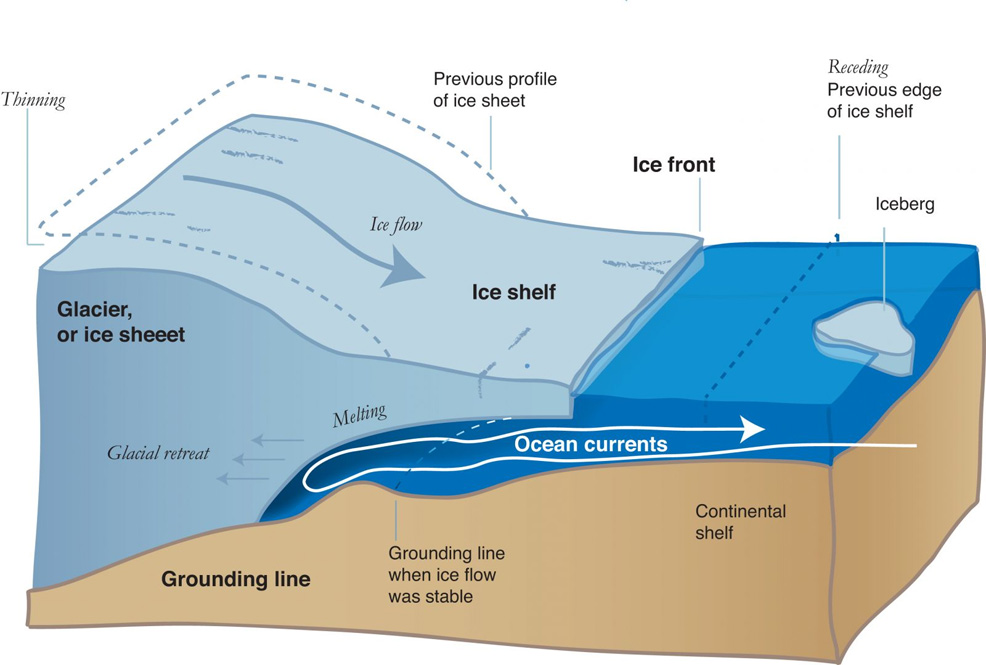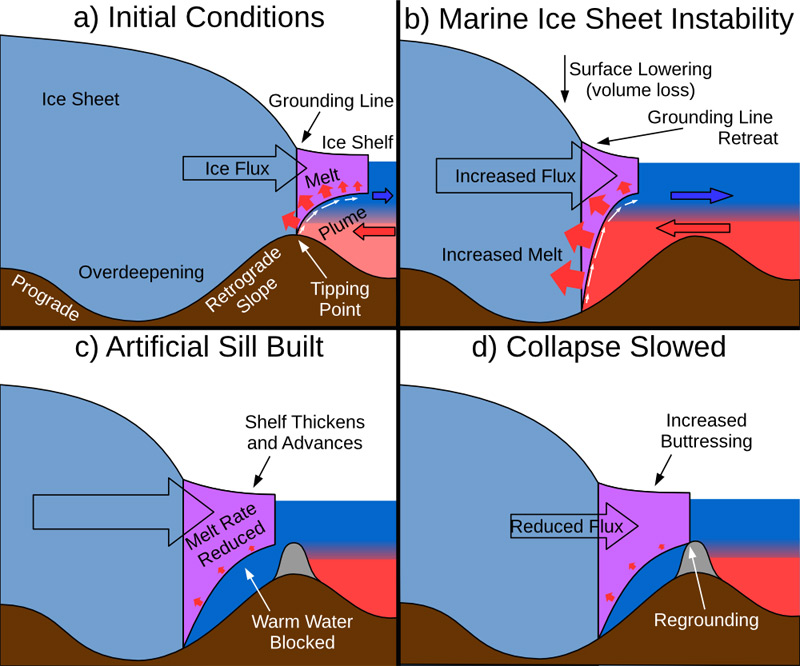
30th September 2018 Giant undersea walls could prevent Antarctic melting A new study suggests that constructing massive "walls" on the seafloor could halt the slide of undersea glaciers, which are melting due to warmer ocean temperatures.
Targeted megaprojects to hold off glacier melting may slow the collapse of ice sheets and limit sea-level rise, according to Michael Wolovick and John Moore – authors of a new paper this month in The Cryosphere, a journal published by the European Geosciences Union. While an intervention similar in size to existing large civil engineering projects would only have a 30% chance of success, a larger-scale project would have better odds and might be technically feasible in the coming decades. "Doing geoengineering means often considering the unthinkable," says Moore, a scientist at Beijing Normal University, China, and a professor of climate change at the University of Lapland, Finland. The term "geoengineering" is usually applied to large-scale interventions to stop climate change. But instead of trying to modify the entire climate, Wolovick and Moore say we could apply a more targeted approach to limit one of the most drastic consequences of climate change: rising sea levels. Their "unthinkable" idea is termed glacial geoengineering: making changes to seafloor geometry near glaciers that flow into the ocean, forming an ice shelf, preventing them from melting further. Some glaciers, such as the Florida-sized Thwaites ice stream in West Antarctica, are retreating fast. According to a NASA study in 2014, Thwaites is on track to collapse in as little as 100 to 200 years (the blink of an eye, in geological terms) and contains enough ice to increase global sea levels by 1.2 metres (4 feet). It has several neighbours adjoining the Amundsen Sea, as shown in the video animation below. A more recent study published in June 2018 found the rate of ice loss from Antarctica has nearly tripled since 2012, and most of the additional melt is from the huge West Antarctic glaciers. "Thwaites could easily trigger a runaway [West Antarctic] ice sheet collapse that would ultimately raise global sea level by about 3 metres," explains Wolovick, who is a researcher at Princeton University's Department of Geosciences, US. This could have dramatic impacts on hundreds of millions of people living around the world's coastal areas.
Instead of – or in addition to – limiting the effects of rising seas through traditional coastal protection, using glacier geoengineering to stop the flood at the source could be a viable option, as Wolovick and Moore show: "The most important result [of our study] is that a meaningful ice sheet intervention is broadly within the order of magnitude of plausible human achievements," says Wolovick. The team looked into two potential designs. One idea would be to build a wall underwater to block warm water reaching an ice shelf's base, which is very sensitive to melting. A simpler design consists of constructing artificial mounds or columns on the seafloor: they wouldn't block warm water, but could support and hold back the glacier, helping it regrow. "In either case, we were imagining very simple structures, simply piles of sand or gravel on the ocean floor," says Wolovick. The team ran computer models, in which they applied these designs to Thwaites Glacier in a warming world. Thwaites is projected to be the largest individual source of future sea-level rise and, at 80 to 100 km, is one of the widest glaciers in the world. "If [glacial geoengineering] works there, then we would expect it to work on less challenging glaciers as well," the authors write.
The results of the computer models showed that even a simpler design could slow down the rate of sea level rise, giving more time for coastal societies to adapt to rising waters. The smallest intervention would have a 30% probability of preventing a runaway collapse of the West Antarctic Ice Sheet and consists of building isolated 300-metre-high mounds or columns on the seafloor, using between 0.1 and 1.5 cubic kilometres of aggregate, depending on the strength of the material. This is similar to the amount that was excavated to build the Suez Canal in Egypt (1 cubic kilometre) or in Dubai's Palm Islands (0.3 cubic kilometres). A more sophisticated project – going beyond the scale of anything humanity has attempted so far – would provide a higher chance of success in avoiding a runaway ice-sheet collapse within the next 1,000 years (the time the simulations run for) and better odds of causing the ice sheet to regain mass. A small underwater wall, blocking about 50% of warm water from reaching the ice shelf base, could have a 70% chance of succeeding. Larger walls would be even more likely to delay or even stop the ice sheet collapse. Despite their encouraging results, the team does not advocate starting these ambitious projects any time soon. While the simplest design would be similar in scale to existing engineering projects, it would be built in one of Earth's harshest environments. So, the engineering details still need to be worked out. Nonetheless, the team wanted to see whether "glacial geoengineering" could work in theory and to get the scientific community thinking about and possibly improving upon these long-term design concepts. "There is going to be some sea level rise in the 21st century, but most models say that the ice sheets won't begin collapsing in earnest until the 22nd or 23rd centuries," said Wolovick. "I believe that what happens in the 22nd or 23rd centuries matters. I want our species and our civilisation to last as long as possible, and that means that we need to make plans for the long term."
Comments »
If you enjoyed this article, please consider sharing it:
|








